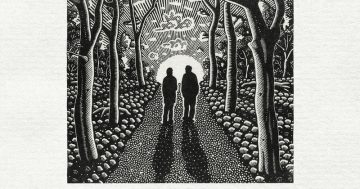Reviewed by Ian Phillips.
By The Garrys, Grey records 2021.
 The Garrys are a Canadian trio comprised of three sisters and Get Thee To A Nunnery is their fourth album.
The Garrys are a Canadian trio comprised of three sisters and Get Thee To A Nunnery is their fourth album.
The album was produced by Canadian music icon Dallas Good of The Sadies.
Get Thee To A Nunnery has a wonderful ‘old school’ feel to it with unfiltered instruments and a surf-rock vibe exemplified by the instrumental second track, Ambrosia Salad.
It could be something from an old Ventures or Aztecs album.
Get Thee To A Nunnery (a line from Hamlet) draws on the girls’ family history and the windswept plains of their Saskatchewan homeland for the inspiration of the songs.
In particular the stories told by their mother of her school years at a Catholic boarding school, and the convent in a small Saskatchewan town in the 1960s.
Coping with the feelings of persistent guilt, seeded by the nuns, that many former Catholic school kids know all too well, and the rebellion that is often associated with it, is explored in several songs including the title track.
It must have been an interesting dichotomy that the girls experienced while putting this album together, listening to their mother’s stories and dealing with the baggage that comes with those who grew up within the narrow confines of this period, while at the same time finding the music and imagery really cool.
Musically the Garry girls paint a picture of the physical desolation, isolation and decay of small country towns like theirs, while at the same time also inferring the inner desolation that many people suffer from because of their traumatic boarding school experiences.
Throughout the album there are spaghetti western musical motifs as if they’d been lifted from some long forgotten Ennio Morricone film score.
And the girls’ melodies and harmonies are very reminiscent of joy and warmth of ‘50s-‘60s girl groups, and the escape from the reality of their repressive existence that this music offered to girls like their mum.
Get Thee To A Nunnery is a fascinating album, it takes us back to a time when life seemed much more straight forward, but in fact it constrained the future of the young (especially women) within the confines of societal and religious expectations that many struggled for much of the remainder of their life to escape from.











